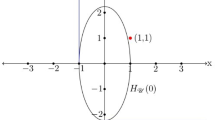Abstract
Relevance and diversity are two desirable properties in data retrieval applications, an important field in data science and machine learning. In this paper, we consider three maximization problems to balance these two factors. The objective function in each problem is the sum of a monotone submodular function f and a supermodular function g, where f and g capture the relevance and diversity of any feasible solution, respectively. In the first problem, we consider a special supermodular diversity function g of a sum-sum format satisfying the relaxed triangle inequality, for which we propose a greedy-type approximation algorithm with an \(\left( 1-1/e,1/(2\alpha )\right) \)-bifactor approximation ratio, improving the previous \(\left( 1/(2\alpha ),1/(2\alpha )\right) \)-bifactor approximation ratio. In the second problem, we consider an arbitrary supermodular diversity function g, for which we propose a distorted greedy method to give a \(\min \left\{ 1-k_{f}e^{-1},1-k^{g}e^{-(1-k^{g})}\right\} \)-approximation algorithm, improving the previous \(k_f^{-1}\left( 1-e^{-k_f(1-k^{g})}\right) \)-approximation ratio, where \(k_f\) and \(k^g\) are the curvatures of the submodular function f and the supermodular funciton g, respectively. In the third problem, we generalize the uniform matroid constraint to the p matroid constraints, for which we present a local search algorithm to improve the previous \(\frac{1-k^g}{(1-k^g)k^f+p}\)-approximation ratio to \(\min \left\{ \frac{p+1-k_f}{p(p+1)},\left( \frac{1-k^g}{p}+\frac{k^g(1-k^g)^2}{p+(1-k^g)^2}\right) \right\} \).
Similar content being viewed by others
Data Availability
The data used to support the findings of this study are available from the corresponding author upon request.
References
Abbasi, Z.S., Ghadiri, M.: Max-sum diversification, montone submodular functions, and semi-metric spaces. CoRR (2015). (abs/1511.02402)
Bai, W., Bilmes, J.A.: Greed is Still Good: Maximizing monotone Submodular+Supermodular (BP) functions. ICML 304–313 (2018)
Baur, C., Fekete, S.P.: Approximation of geometric dispersion problems. Algorithmica 30(3), 451–470 (2001)
Bhattacharya, S., Gollapudi, S., Munagala, K.: Consideration set generation in commerce search. WWW 317–326(2011)
Birnbaum, B., Goldman, K.J.: An improved analysis for a greedy remote-clique algorithm using factor-revealing LPs. Algorithmica 55(1), 42–59 (2009)
Bilmes, J., Bai, W.: Deep Submodular Functions. arXiv:1701.08939 (2017)
Borodin, A., Jain, A., Lee, H.C., Ye, Y.: Max-sum diversification, monotone submodular functions and dynamic updates. ACM Trans. Algorithms 13(3), 41:1-41:25 (2017)
Ceccarello, M., Pietracaprina, A., Pucci, G., Upfal, E.: MapReduce and streaming algorithms for diversity maximization in metric spaces of bounded doubling dimension. PVLDB 10(5), 469–480 (2017)
Cevallos, A., Eisenbrand, F., Zenklusen, R.: Local search formax-sum diversification. SODA 130–142(2017)
Chen, W., Chen, y., Weinberger, K. Q.: Filtered search for submodular maximization with controllable approximation bounds. AISTATS, 156-164 (2015)
Conforti, M., Cornuéjols, G.: Submodular set functions, matroids and the greedy algorithm: tight worst-case bounds and some generalizations of the Rado-Edmonds theorem. Discr. Appl. Math. 7(3), 251–274 (1984)
Ghadiri, M., Schmidt, M.:Distributed maximization of “Submodular plus Diversity” functions formulti-label feature selection on huge datasets. AISTATS 2077–2086 (2019)
Goldengorin, B.: Maximization of submodular functions: theory and enumeration algorithms. Eur. J. Oper. Res. 198(1), 102–112 (2009)
Goldengorin, B., Sierksma, G., Tijssen, G.A., Tso, M.: The data-correcting algorithm for the minimization of supermodular functions. Manag. Sci. 45(11), 1539–1551 (1999)
Gollapudi, S., Sharma, A.: An axiomatic approach for result diversification. WWW 381–390(2009)
Gong, S., Nong, Q., Liu, W., Fang, Q.: Parametric monotone function maximization with matroid constraints. J. Glob. Optim. 75(3), 833–849 (2019)
Hassin, R., Rubinstein, S., Tamir, A.: Approximation algorithms for maximum dispersion. Oper. Res. Lett. 21(3), 133–137 (1997)
Indyk, P., Mahabadi, S., Mahdian, M., Mirrokni, V.S.: Composable core-sets for diversity and coverage maximization. PODS 100–108 (2014)
Krause, A., Golovin, D.: Submodular function maximization. Tractability, 71–104 (2014). http://www.cs.cmu.edu/dgolovin/papers/submodularsurvey12.pdf
Lee, J., Mirrokni, V.S., Nagarajan, V., Sviridenko, M.: Maximizing nonmonotone submodular functions under matroid or knapsack constraints. SIAM J. Discr. Math. 23(4), 2053–2078 (2010)
Palubeckis, G.: Iterated tabu search for the maximum diversity problem. Appl. Math. Comput. 189(1), 371–383 (2007)
Ravi, S.S., Rosenkrantz, D.J., Tayi, G.K.: Heuristic and special case algorithms for dispersion problems. Oper. Res. 42(2), 299–310 (1994)
Sviridenko, M., Vondrák, J., Ward, J.: Optimal approximation for submodular and supermodular optimization with bounded curvature. Math. Oper. Res. 42(4), 1197–1218 (2017)
Ward, J.: Oblivious and non-oblivious local search for combinatorial optimization. PhD thesis, University of Toronto (2012)
Wu, Q., Hao, J.: A hybrid metaheuristic method for the maximum diversity problem. Eur. J. Oper. Res. 231(2), 452–464 (2013)
Acknowledgements
The first author’s research is partially supported by NSFC (Nos. 11871280 and 11471003). The second author’s research is supported by NSFC (No. 61772005) and Outstanding Youth Innovation Team Project for Universities of Shandong Province (No. 2020KJN008). The third author’s research is supported by the Natural Sciences and Engineering Research Council of Canada (NSERC) Grant 06446, and NSFC (Nos. 11771386 and 11728104). National Natural Science Foundation of China (No. 11871081) and Beijing Natural Science Foundation Project No. Z200002. The fifth author’s research is partially supported by NSFC (Nos. 11871280 and 11971349) and Qinglan Project.
Author information
Authors and Affiliations
Corresponding author
Additional information
Publisher's Note
Springer Nature remains neutral with regard to jurisdictional claims in published maps and institutional affiliations.
Rights and permissions
About this article
Cite this article
Liu, Z., Guo, L., Du, D. et al. Maximization problems of balancing submodular relevance and supermodular diversity. J Glob Optim 82, 179–194 (2022). https://doi.org/10.1007/s10898-021-01063-6
Received:
Accepted:
Published:
Issue Date:
DOI: https://doi.org/10.1007/s10898-021-01063-6




